Painting your cabinets is a perfect way to makeover a dated kitchen without splurging on a big renovation. It doesn’t cost much and, with the proper preparation, your paint job will look great and last a long time. We’ve used the tutorial outlined below to paint cabinets in 4 separate kitchens (not to mention cabinets in other rooms too) so we’re confident it’s a DIY project that will work for you. Follow along below!

The kitchen featured in this tutorial is from our second house which had solid oak cabinets throughout (along with wood paneling!). So while steps focus specifically on painting wood cabinets, the process is similar for any cabinet material. You can also refer to our tutorials about painting already-painted cabinets and painting Ikea cabinets.
Steps To Painting Cabinets
Here is a brief overview of how to paint your kitchen cabinets. The process takes time, patience, and a little bit of elbow grease – but nothing is especially complicated or tiring. At worst, it’s just a bit repetitive – especially if you a big kitchen.
- Remove cabinet doors and hardware
- Patch cracks and holes (optional)
- Lightly sand all surfaces
- Apply a liquid deglosser
- Prime one coat
- Paint two coats
- Rehang cabinet doors
- Reinstall cabinet hardware
This project can be completed by one person but may go faster with help. Proper surface preparation is the key to success here, so don’t rush steps 2-5.
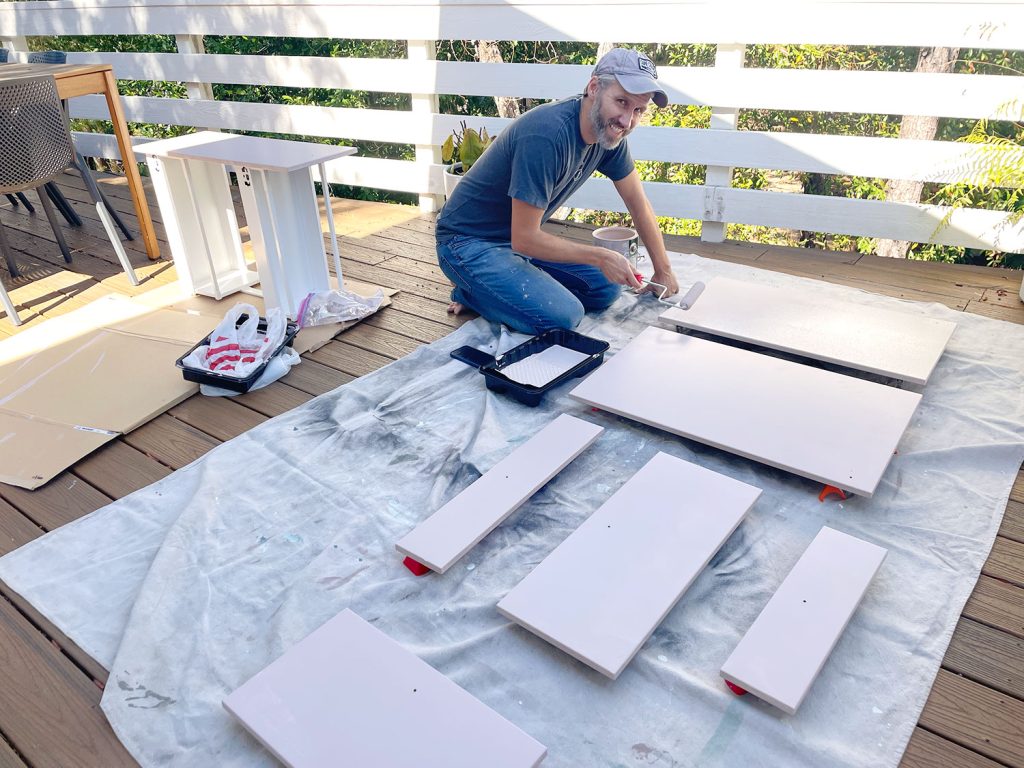
The overall time lime depends on the size of your kitchen, but even painting a small kitchen will span several days due to drying and curing time between coats. You also want to make sure you have ample space to spread out your cabinet doors, like in a garage or spare room.
How To Paint Cabinets Video Overview
You can see these steps in motion by watching the detailed video below. To view an abbreviated version of this process, you can see a quick version of painting cabinets on YouTube.
Note: You can also watch the video above on YouTube.
Supplies Needed To Paint Cabinets
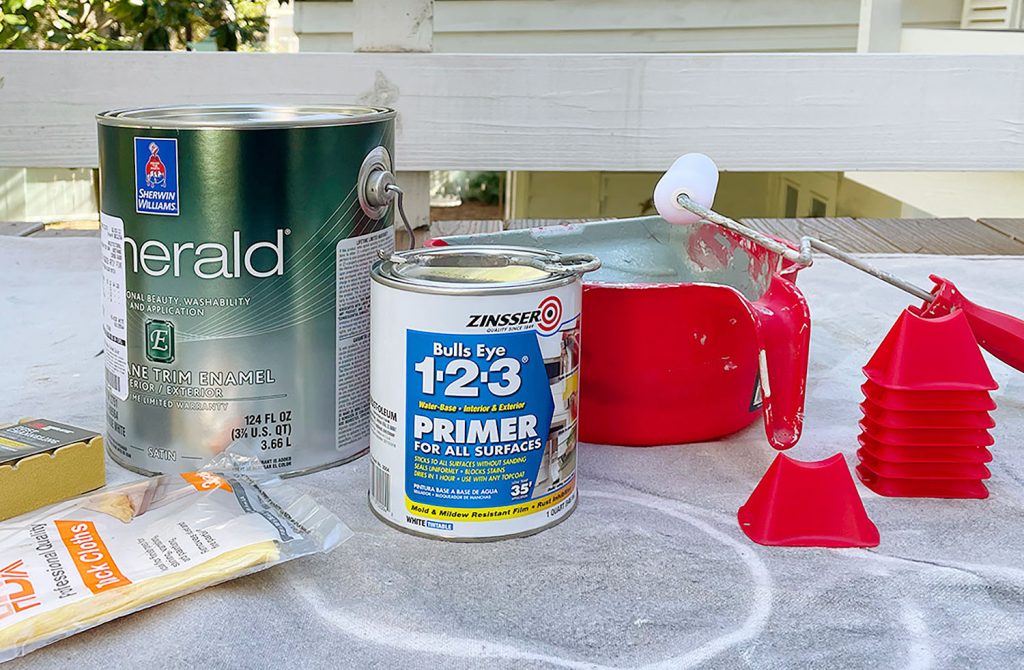
The materials you’ll need to paint your kitchen cabinets aren’t much different from other painting projects. So you may have many of these supplies already on hand.
- Primer
- Paint (we recommend satin or semi-gloss finish)
- Small 4? or 6? foam rollers
- Roller trays
- Short, angled paint brush
- Drop cloths
- Painter’s tape
- Painter stands or tripods
- Electric sander & sandpaper
- Electric drill & driver
- Liquid deglosser
- Wood filler (optional)
- Putty knife (optional)
You could use a paint sprayer for this project, but we don’t feel it’s necessary. If you already own a paint sprayer and are comfortable using it, go for it. It can save time. But we’ve never regretted painting by hand instead.
What paint should I use to paint my cabinets?
Water-based, latex paints formulated for cabinets or trim are best for painting kitchen cabinets. Oil-based paints used to be recommended, but are not necessary or practical for a DIYer. They are smelly, difficult to clean up, and can yellow over time. Also, water-based paints have come a long way and offer a similarly smooth and durable finish. Our favorite cabinet paints are Sherwin-Williams Emerald Urethane Trim Enamel and Benjamin Moore Advance. If you prefer a different brand, consult the paint desk expert for the best formula for your job. Buy the highest quality paint your budget allows.
Step 1: Remove cabinet doors & hardware
Carefully unscrew all cabinet doors from the frames using an electric driver. Remove existing hinges, knobs, pulls, or other hardware. If you are reusing this hardware, be sure to collect it in a bag or box for later. You may also want to label each door with painter’s tape (I.e. “lower left stove cabinet”) to help avoid confusion during reassambly.
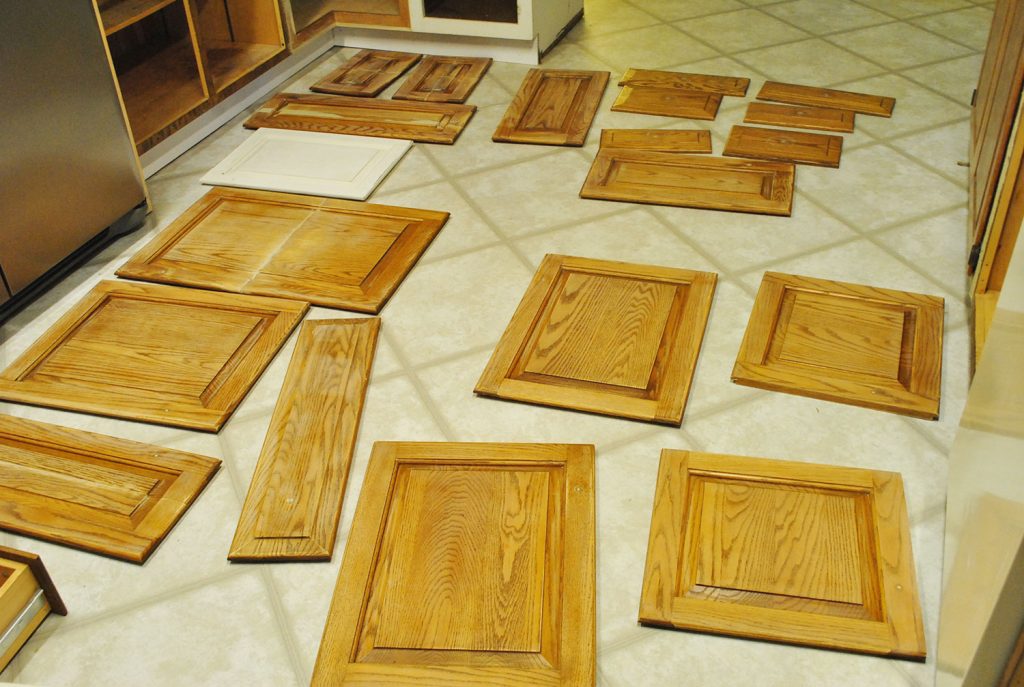
You will also need to slide out any drawers from the frames. If possible, unscrew the drawer front from the box. You may also need to empty some drawers and cabinets. We don’t typically paint the inside of the cabinets, so most things can stay in place while you work. But take care to cover or temporarily move items while you sand, to keep them from getting dusty.
Step 2: Patch cracks and holes (optional)
You can skip this step if your cabinets are in good condition and you’re reusing the existing hardware placement. For our cabinets, however, we planned to swap the existing single-hole knobs for two-hole pulls. The existing hole was in the wrong place, so we used wood filler to patch all of the existing hardware holes before proceeding. We were also changes the hinges, so we patches the holes for those too on both the doors and frames.
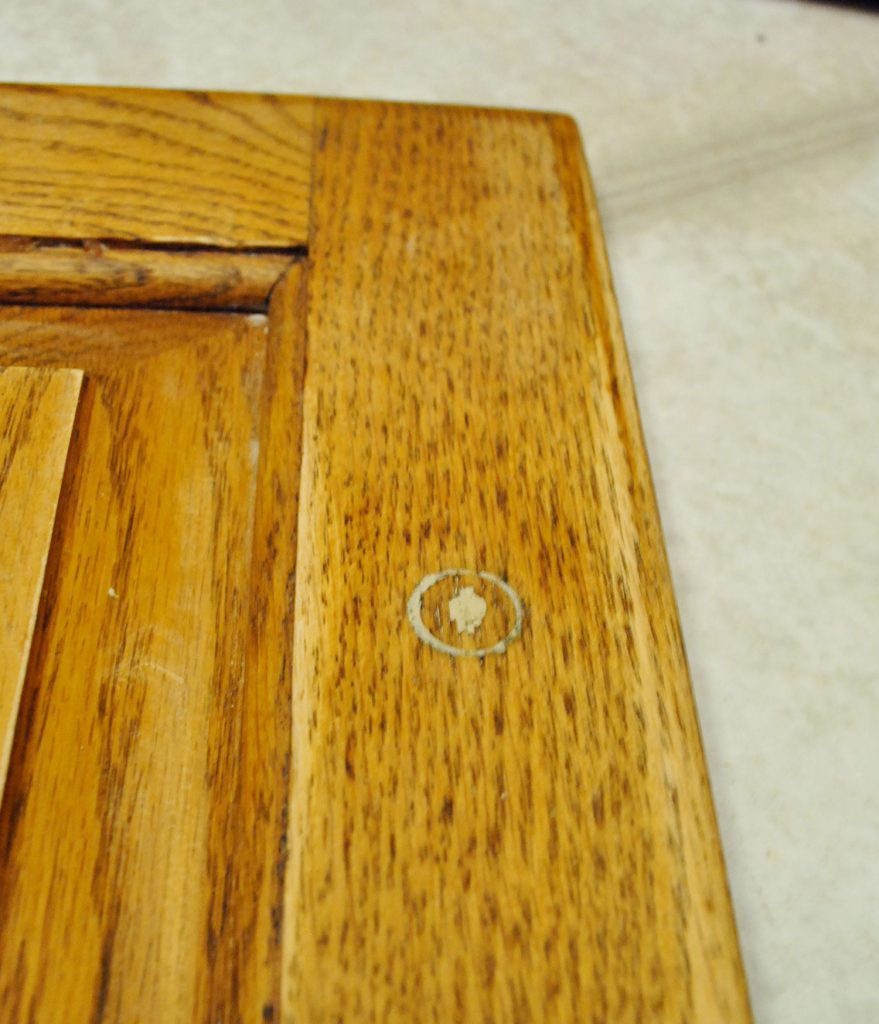
To apply the wood filler, use a putty knife to push it into the hole and smooth it. Once dried, sand off the excess. You may need to do a second coat, since it may shrink slightly as it dries.
Step 3: Lightly sand all surfaces
Prepping your wood cabinets for paint is the MOST IMPORTANT step if you want a long-lasting, durable result. Skipping the next few steps puts your paint job at risk of scratching or rubbing off, especially in high-traffic areas. So while this part is probably the most labor-intensive, please don’t shortchange it! We also have more detail in a dedicated post about prepping cabinets for paint. Here is an overview:
Use an electric sander and medium-grit sandpaper (like 120) to lightly sand every surface you will be painting. This means doors, drawer fronts, faces of cabinets, sides of cabinets, etc. You do NOT need to remove all of the existing finish. The goal is NOT to get it back to raw wood (although that it is okay). The goal is simply to rough up the surface enough to help primer and paint bond to it. You may need to hand sand small corners and nooks.
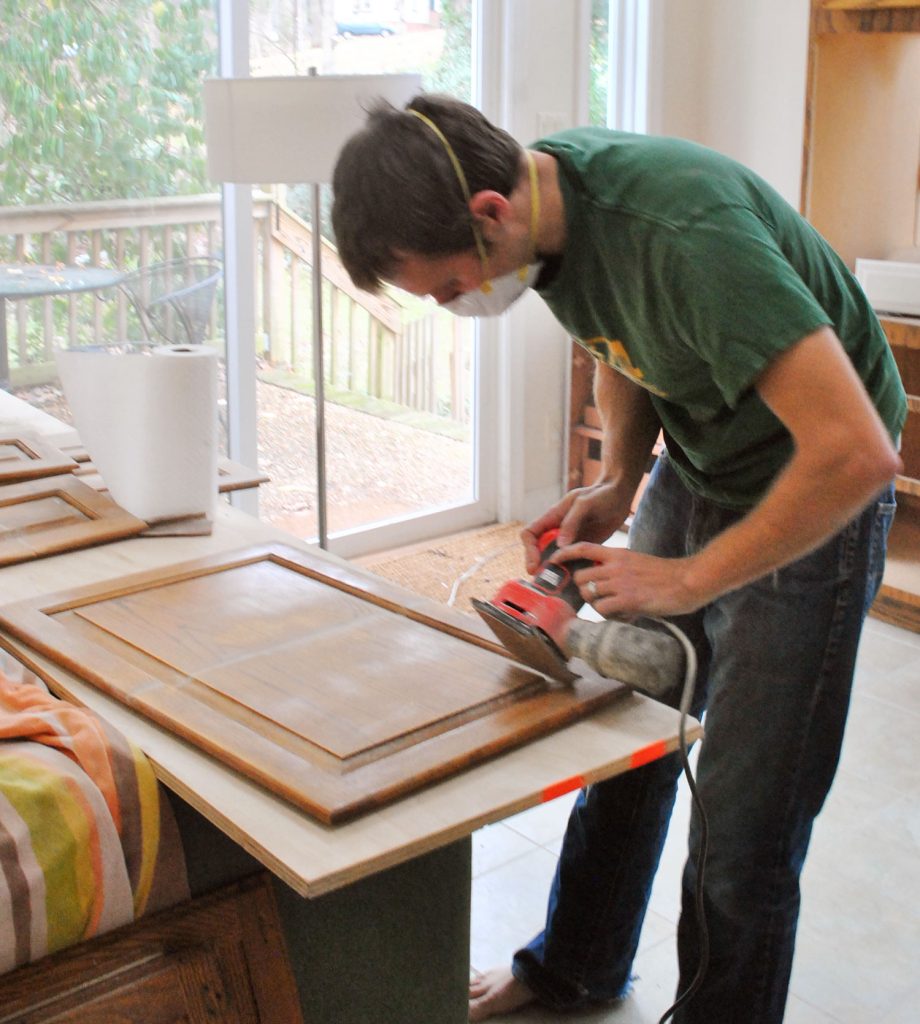
This process will be dusty, so try to do it outside or in a well-ventilated space (we did most of ours in our sunroom, above). When it comes time to sand the frames in place, cover items in your kitchen as needed to keep sanding dust from getting everywhere. After you’re done sanding, wipe your cabinets clean using a tack cloth.
Step 4: Apply a Liquid Deglosser
Liquid deglosser (sometimes called “liquid sandpaper”) helps etch the surface of your cabinets & frames, helping ensure a strong bond with the paint. Krud Kutter Gloss Off is our preferred deglosser. The one pictured below is difficult to find.
Some people use a liquid deglosser in place of sanding, but for wood cabinets we recommend doing both to be safe. It also helps remove any built-up grease or oil residue you may have missed while sanding, especially in nooks and crannies. You may also have heard of using a chemical called TSP (trisodium phosphate) instead. However, TSP is more of a cleaner than a deglosser, so we don’t recommend it.
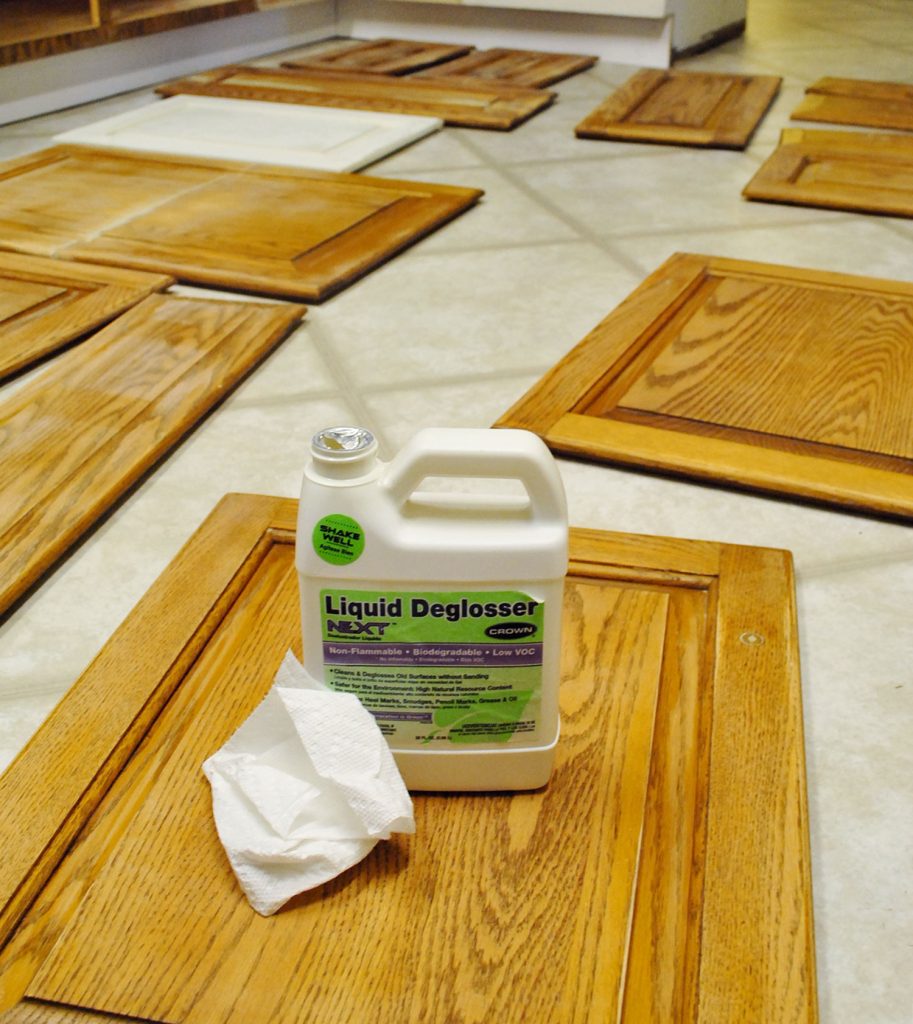
You can apply it with a rag or paper towel or put it in a spray bottle. It doesn’t need to be rinsed or wiped off. Just give it a few minutes to soak in. We sometimes do two applications to be safe.
Step 5: Prime One Coat
The last prep step before painting is priming! Primer is a critical element to good coverage and a long-lasting finish. Do not skip it! We like a Zinsser all-surface primer. It can be used off-the-shelf if you are painting your cabinets white or another light color. For darker or more saturated paints, consider having your primer tinted to match.
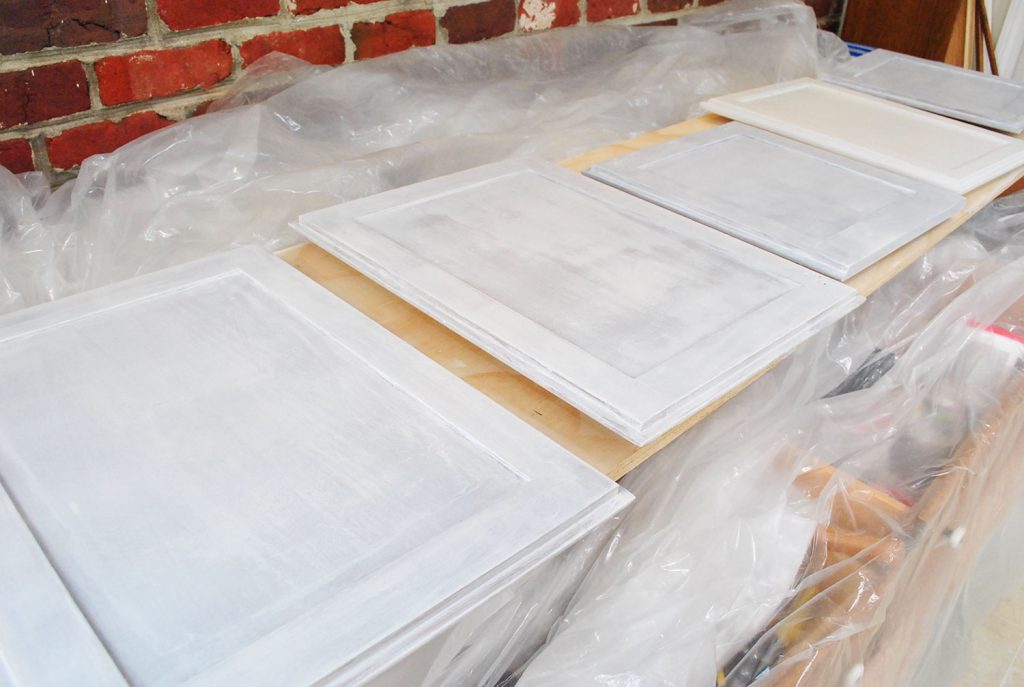
As you can see above, you’re not going for perfect coverage. Primer will be splotchy as it dries. This is okay. The main goal is to get a thin, smooth, and even coat. To do this, we recommend (1) using an angled paintbrush to get into edges or corners, then (2) using a small foam roller to remove brush strokes and coat the large, flat surfaces. Go slow and watch for drips along edges!
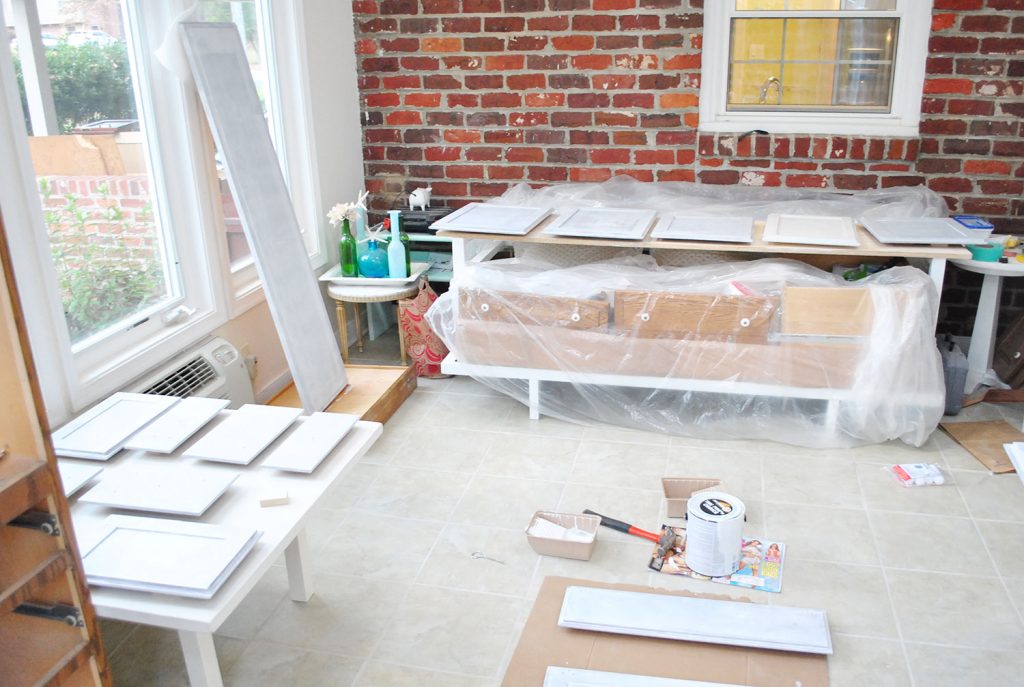
We suggest propping your doors off the ground with painter stands to make priming and painting easier. And if you’re painting both sides of your doors (which we think you should!) we’ve developed a specific order that helps minimize marks or dings on your freshly painted doors. It requires a bit of patience as you wait for one side to fully dry before flipping it over to do the other.
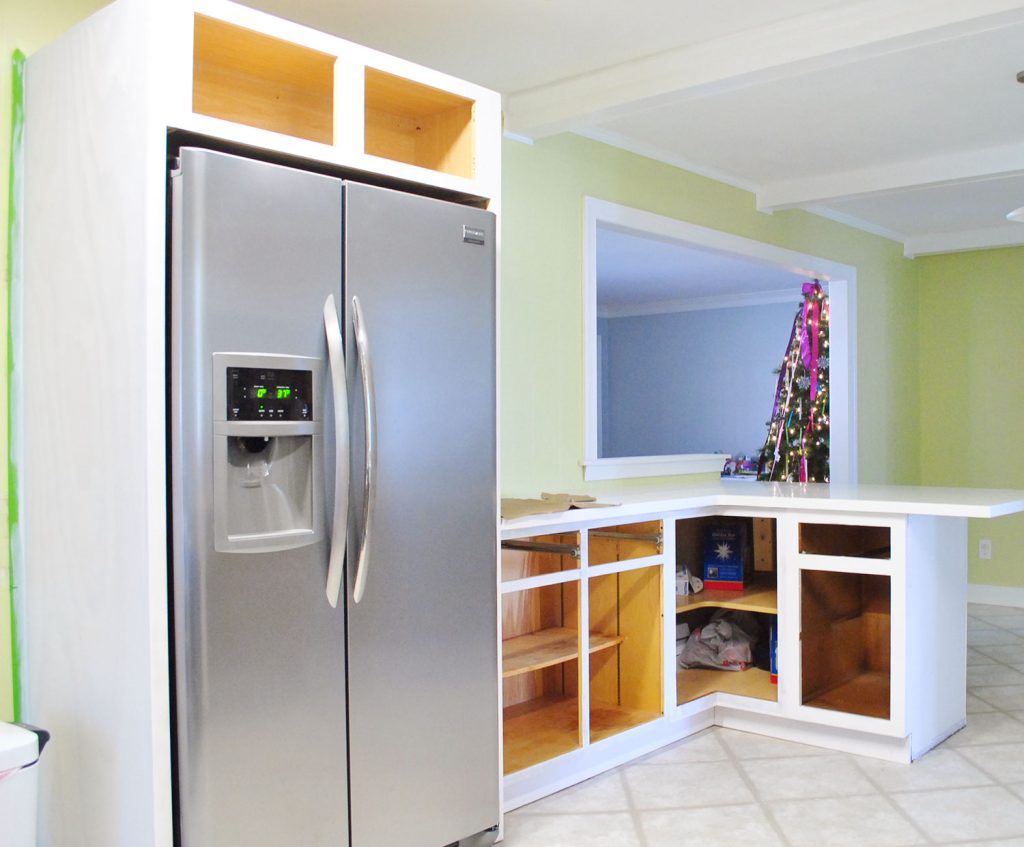
Don’t forget to do your cabinet frames and boxes too! You may want to use painter’s tape and drop cloths to protect walls, floors, appliances, and countertops.
Step 5: Paint Two Coats
Once your primer coat has fully dried and cured (see the manufacturer’s instructions on the can for specific times), you may repeat this process with your chosen paint. We used the color Benjamin Moore Cloud Cover. Again, use a combination of a brush and foam rollers to get a smooth finish. The paint may look slightly textured from the foam roller, but it will even out as it dries. Just remember: your main goal is thin & even coats without drips!
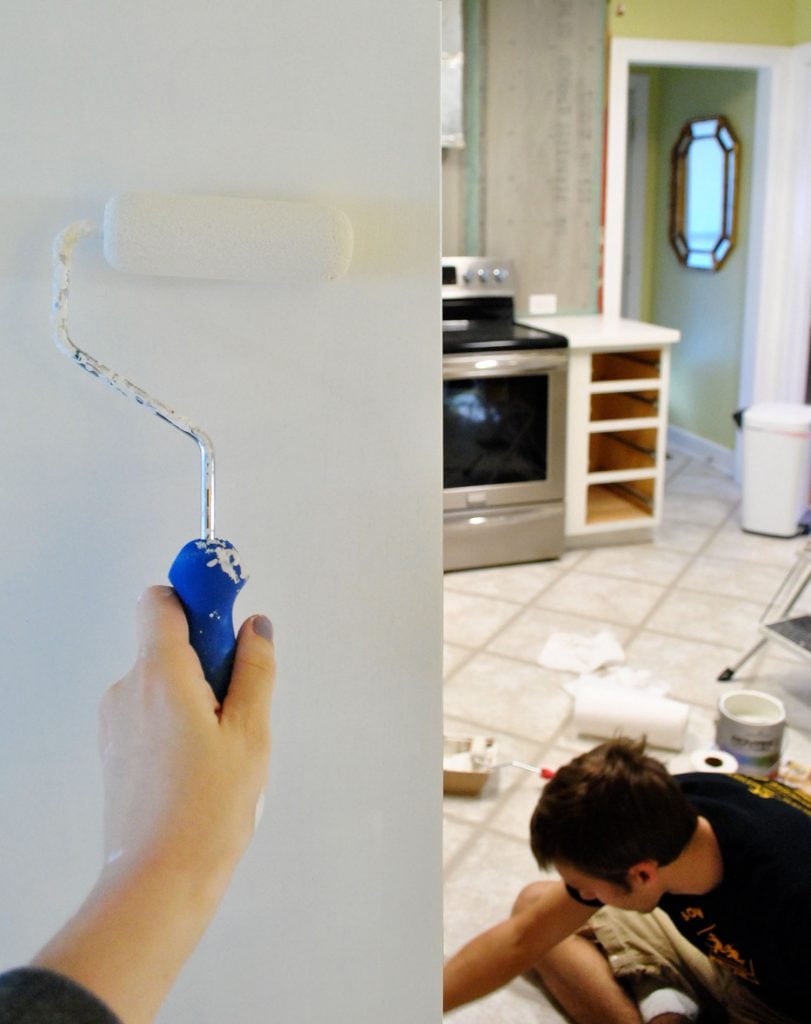
As a rule of thumb, we do two coats of paint for any painting project. But it’s especially important with painting cabinets. More thin layers is stronger and less prone to scratches than one thick layer. Just be sure to allow enough dry time between coats before touching or recoating.
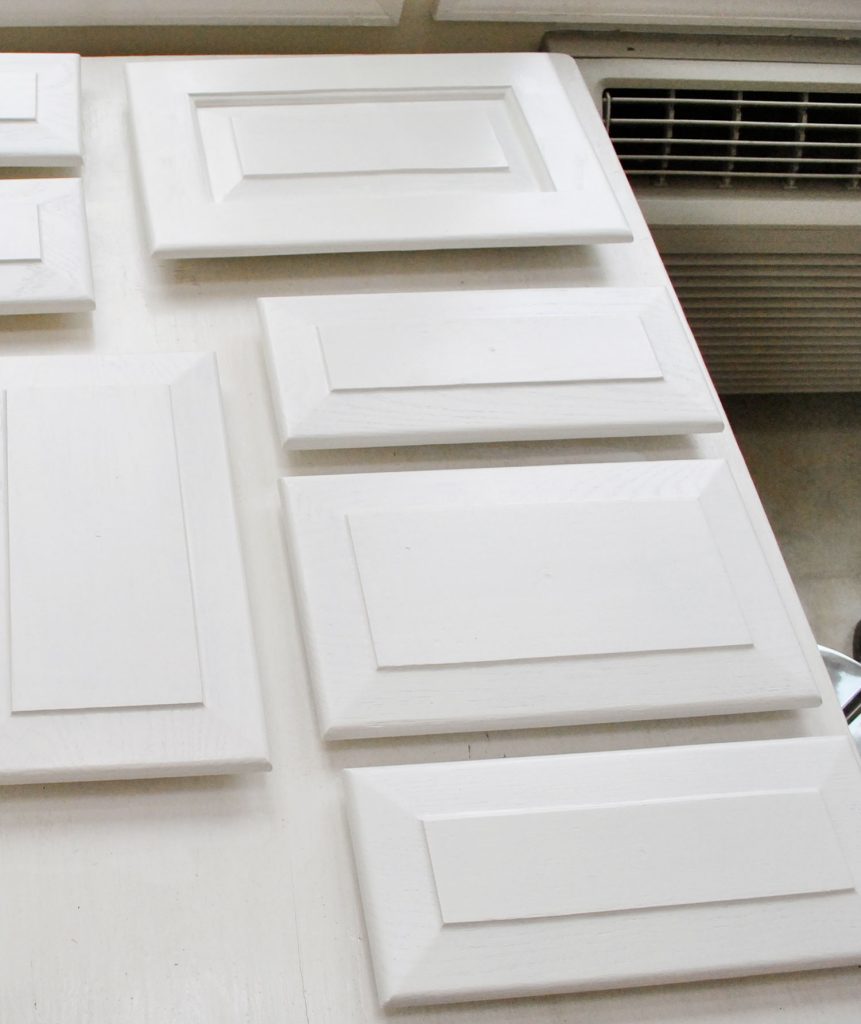
This part should be super satisfying. You’re finally seeing your hard work pay off and your vision come to life!
Step 7: Rehang cabinet doors
Once everything has fully dried, you can reassemble your kitchen. Screw hinges back on. Slide drawers back in place. You can even put things back in your cabinets.
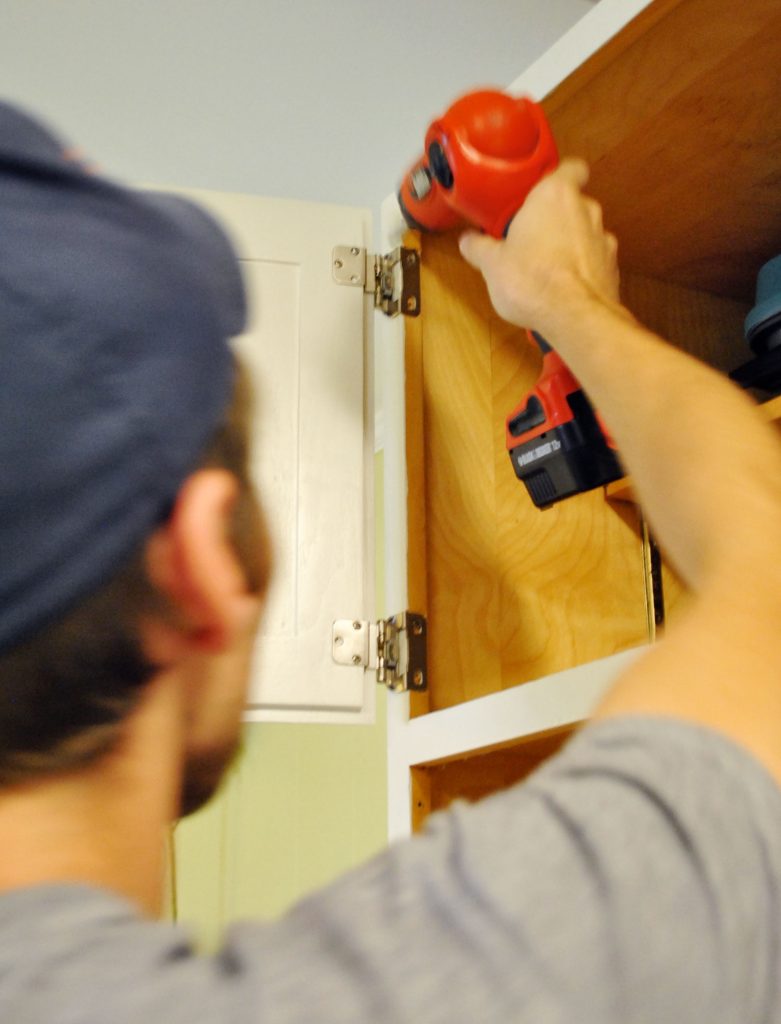
Things might get banged around in this process, so we often like to give our paint an extra day to cure before beginning. You’d hate to scuff up or scratch off the fresh paint right away!
Step 8: Reinstall cabinet hardware
At the same time, you can all reattached your cabinet knobs or pulls. However, this will be a bit more involve if you – like us – filled all of the old holes and need to make new ones.
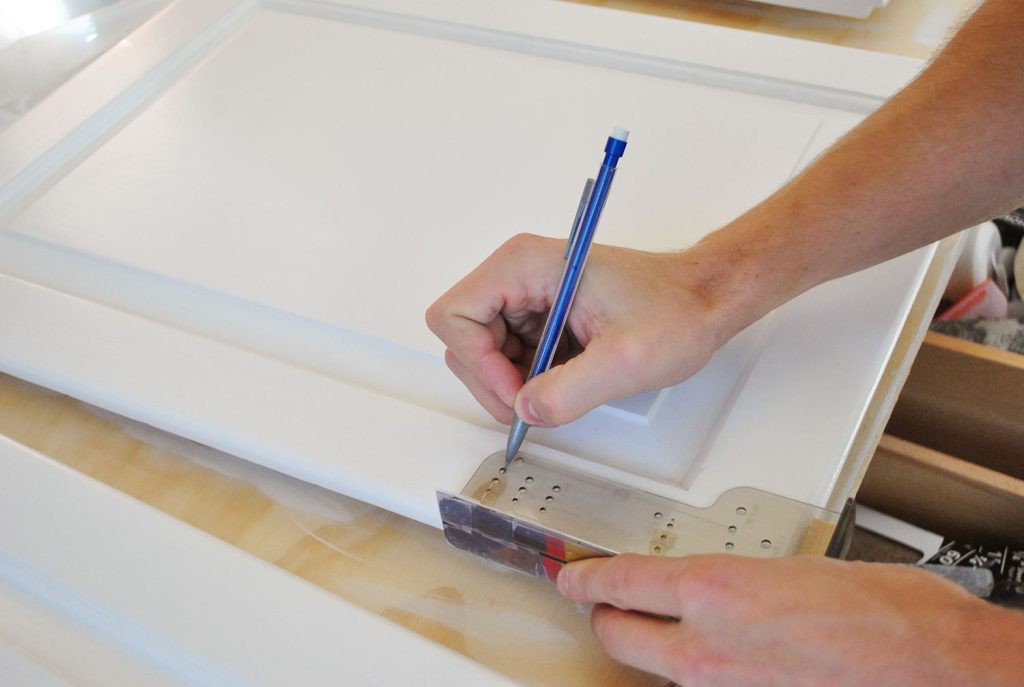
We have an entire post – with video! – dedicated to how to install cabinet hardware that will help you do this with precision and speed. But as you can see above, we highly recommend purchasing a hardware template for this step.
How long does it take to paint kitchen cabinets?
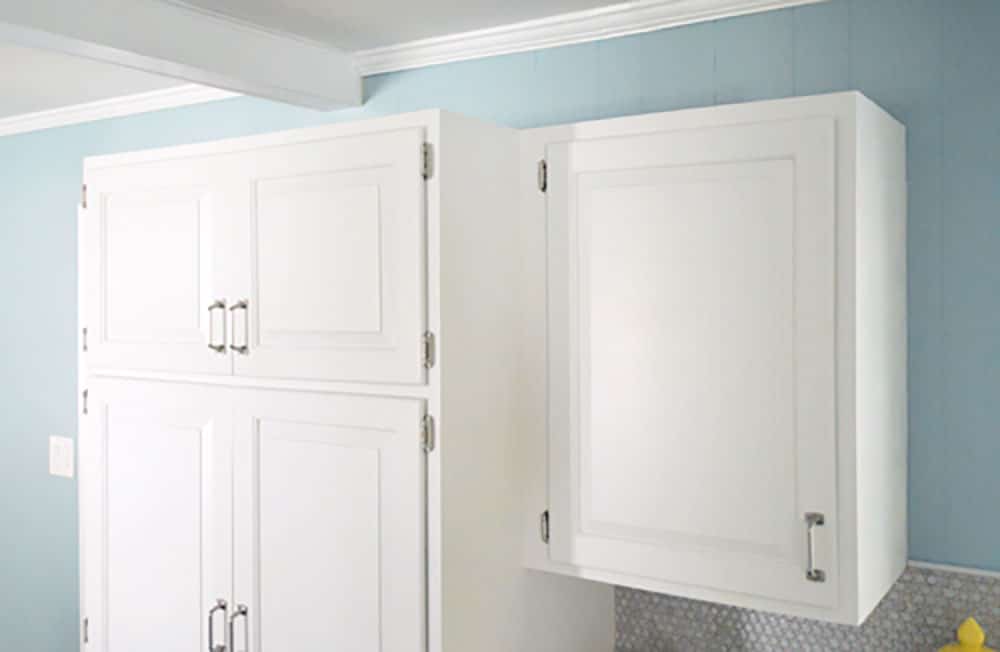
Painting these kitchen cabinets took us 15 days to complete. A lot of that time, however, was waiting for things to dry and cure. They were not 15 days of straight work! So while this isn’t a project you should expect to knock out in a weekend, it’s also not something you need to take 2 weeks off of work to complete. It can easily be done on nights and weekends, like we did. We even had a toddler at the time!
How much does painting cabinets cost?
Painting kitchen cabinets yourself is very affordable, especially compared to the alternative of hiring it out OR replacing your cabinets entirely. We completed this project in 2012 for just $300 and half was for new hinges and pulls. So if you are reusing your hardware, you can expect to spend even less. Here is a rough estimate of what you might spend to paint kitchen cabinets.
- Sandpaper: $10
- Liquid deglosser: $10
- Primer, 1 gallon: $30
- Paint, 1 gallon: $80 – $120
- Paint supplies (roller, brush, trays, etc): $40 – $60
- TOTAL COST: $170 – $230
If you don’t already own an electric sander or drill, those may cost you about $50 each. You can complete those tasks by hand to keep your budget down, but it will significantly increase your time and effort.
Other Cabinet Painting FAQs
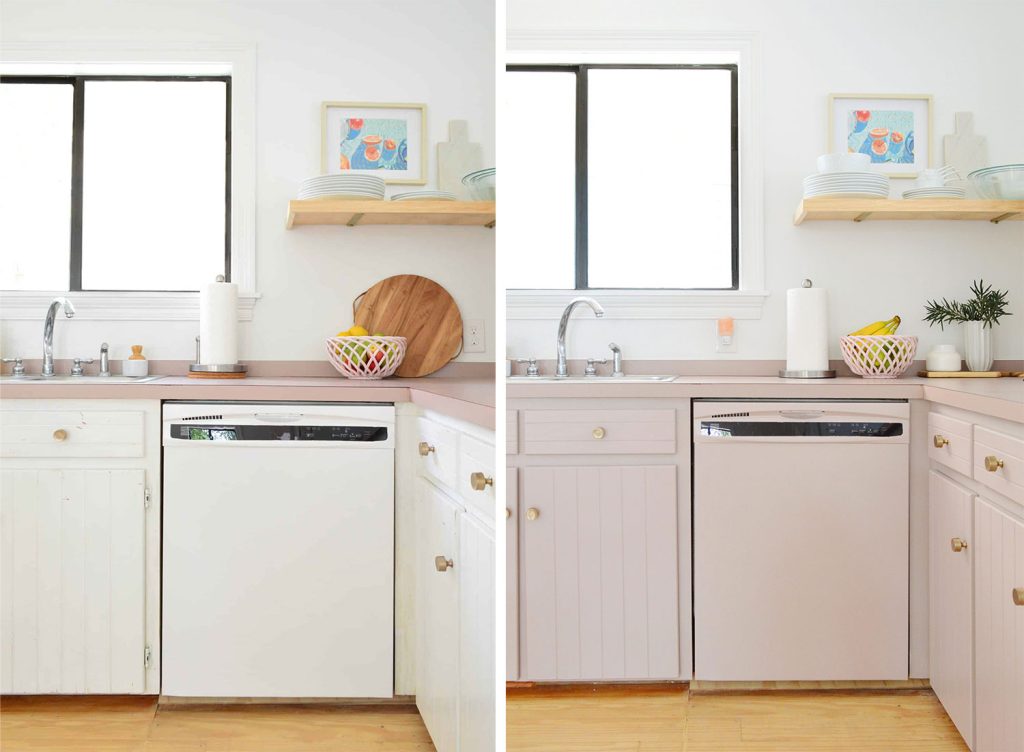
Here are some other frequently asked questions about painting kitchen cabinets:
Do I need to apply a sealer or topcoat?
No, you do not need to apply a sealer, varnish, or polyurethane to your painted cabinets. Paints, especially those formulated for cabinets or trim, don’t require a protective topcoat. In fact, applying one could cause your color to yellow.
What finish paint should I use on cabinets?
We recommend using a satin or semi-gloss paint for a hard, wipeable finish on cabinets. Gloss or high-gloss paint can offer a sleek, modern look with high shine, but should be applied professionally with a paint sprayer to avoid brush or roller strokes. Matte, flat, or eggshell finishes will be harder to wipe clean.
What color should I paint my cabinets?
There is no limit to the colors you can paint kitchen cabinets! We love classic white cabinets, but colorful cabinets have also been trending lately – like our current cabinets (Artsy Pink by Sherwin-Williams) or our friends’ painted cabinets below (Halcyon Green by Sherwin-Williams).
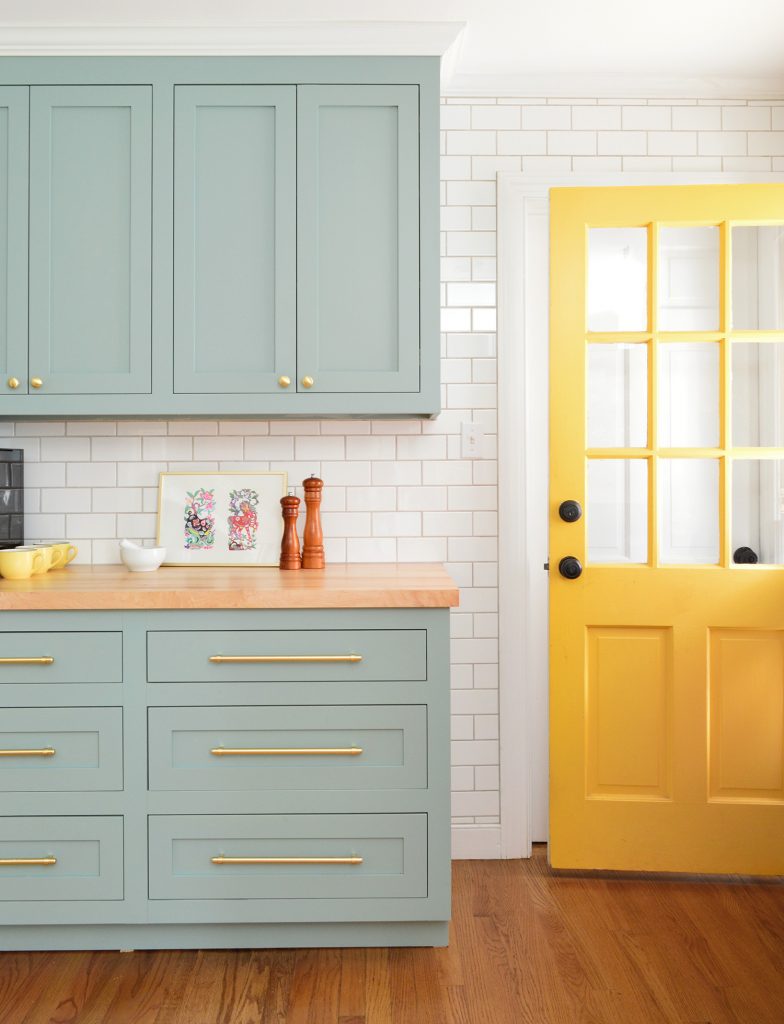
We always recommend testing any color before proceeding. Colors often appear brighter or more saturated than they seem on a small swatch. Whites also can appear stark or cold, so we recommend something with subtle yellow or gray. Any of these expert’s favorite white paints work well on cabinets.
More Kitchen Cabinet Projects
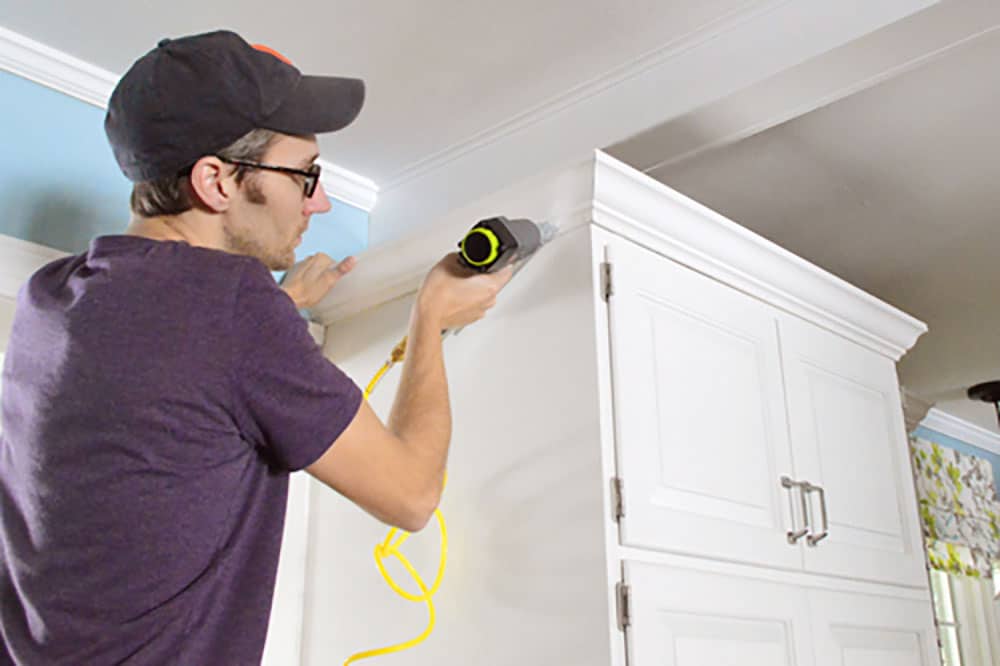
Looking for other budget-friendly ways to update your kitchen? Here are some other projects you might be interested in:
- How to Add Crown Molding To Cabinets
- How to Properly Prep Cabinets For Paint
- How To Paint Ikea Cabinets
- How to Install Kitchen Hardware
- Organizing a Small Kitchen
- Installing Hidden Ginges on Old Cabinets
- Staining Wood Cabinets Darker without Sanding
Update: Our painted cabinets are still holding up great. Check out a little update post here.
*This post contains affiliate links, so we may earn a small commission when you make a purchase through links on our site at no additional cost to you.

melinda says
I LOVE your kitchen!!! I was wondering what brand and color of white you used for your paint??
YoungHouseLove says
Thanks! We used Cloud Cover by Benjamin Moore.
xo
s
Angelica says
Great kitchen painting tutorial. Planning on painting my kitchen cabinets white and loved your step by step information and tips. One question though- is a topcoat something you used in your project? Do you think it’s a necessary step? Why use latex versus oil based paint for the cabinets? love your website.
YoungHouseLove says
Nope, almost every expert agrees that proper prep (sanding, deglossing, and priming) along with using a high quality self leveling paint (like BM Advance) is all you need. A topcoat of sealer can actually crack or yellow, so it’s best to skip it and go with good prep and great paint. As for using latex, it’s just the newest stuff on the market meant for a job like this and it does it amazingly well. A year later and our cabinets look mint!
xo
s
Angelica says
Thanks for your quick response. I will definitely check out the BM advance paint for the kitchen project. I already painted our master bath cabinets black to somehow calm down our dark emerald green cultured- marble bathtub and vanity counter. I sanded, deglossed and primed those cabinets with good products after seeing your tutorial. thank you so much for your help. -Angelica
YoungHouseLove says
Sure thing! Good luck!
xo
s
Maria says
I’m finally putting this tutorial to use and painting my ugly cabinets! So far so good! I can’t thank you enough for putting this out here.
I installed concealed/European hinges on my cabinets, which didn’t have them originally. I’d love to see you guys create an entry about choosing the right concealed hinges and installing them. It’s really easy with the cheap Liberty hardware guide, which comes with a 35mm Forstner bit, but the internet kept telling me I’d need aaaaall this expensive equipment to do it, or even a drill press! The only other thing I needed was a 5/16″ drill bit. I want to spread the word!
YoungHouseLove says
That’s awesome Maria! Thanks for sharing!
xo
s
Lydia K says
Hi guys! Y’all are so awesome.
We’re about to take on a similar project in our kitchen (and probably downstairs bath, as well) – a bit of a bandaid on an ugly kitchen while we save the bucks to do a full reno. Our cabinets will be going from pretty much exactly what yours looked like to a matte black with shiny nickel handles. I’m loving all the detailed instructions on how to tackle this, as well as the realistic timeframe for how long it takes. (It always blows my mind on DIY shows when they redo an entire kitchen in like 2 days. What the what?!)
There’s one problem we’re having that I’m not quite sure how to handle, though. The outside panels (the two ends of our L-shaped kitchen uppers) are both finished in this sort of wood-like sticker decal. I’m pretty sure underneath it’s just particle board. I wondered, can I sand that down just like any other finish, and paint right over it? Or should we get some thin finishing board and just cover it up with fresh wood before we paint? I can’t seem to find an answer to this anywhere, though clearly everyone has to have faced this problem before when updating boring builder-grade cabinets. Wondered if you had any insight. Thanks!! Love the blog & the book!
YoungHouseLove says
Hmm, I bet any number of those things could work. I would try painting over it first (can’t hurt) and if that works you’re done. If it doesn’t work, then you can sand it or peel it and try to paint what’s under it (or reface it if that turns out to be the best solution). Good luck!
xo
s
Sarah says
Okay, I would love more info on the coupon for your Benjamin Moore Advance Paint. $40?! I haven’t even found it near me, but I’m looking, and I’m thinking it will be more like $70…
Thanks for your blog. Love it, love it, love it.
YoungHouseLove says
The local store where we get our BM paint is called Virginia Paint and I “like” them on Facebook, which is how I see when they share coupons and discounts (sometimes $5-10 off, and it’s usually $50-60 depending on the type of paint). I’m sure that varies a lot by store though. Hope it helps!
xo
s
Emily says
Since it’s been over a year that you guys have painted your kitchen cabinets, I’m super curious as to how they are holding up? I am wanting to paint our kitchen cabinets, but I am still nervous that they won’t last for the long haul.
YoungHouseLove says
They’re mint! We swear by this method and also by the specific primer and paint (we have no idea how they’d hold up if you used different materials and applied them in different ways) and we’re so happy with them! Clara bangs on our cabinets with cars and I don’t even flinch anymore. Whew!
xo
s
Ronda says
Thank you! You, your website and ideas inspire and support me in redecorating and making my ‘old’ home more beautiful and comfortable! Your family is adorable! Best for you.
dawn says
i’m shocked, your kitchen looks AMAZING! so amazing that now i want to do our kitchen. a quick question, why did you choose to use a brush vs a paint sprayer? again, it looks amazing, job well done!
YoungHouseLove says
We don’t own a paint sprayer, so that was our main reason – and we’ve had such great luck with brushing and rolling that we didn’t see the reason to go out and buy one for just this purpose.
-John
Barbara says
I love that you left the inside of the cabinets natural for all the reasons you mentioned, but are they sealed in any way or just raw wood? We are building cabinets with a smooth furniture grade wood, but I wonder if I should seal the inside and if so, with what?
YoungHouseLove says
They seem to be sealed (not super glossy though, maybe just a matte coat of poly?
xo
s
Angelica says
Hi again. Quick ? I started using the BM Advance paint (after primer was dry) and the foam roller seemed to leave behind a ton of tiny air bubbles. Did you experience this when foam rolling? It seems to have less bubbles when I switched to a synthetic 1/4 inch nap roller. I do love how the BM paint levels brush strokes but the air bubbles won’t go away. I have never had air bubble issues when painting other furniture with Behr paint.
Angelica says
One more question – Did you sand between paint coats for an even smoother finish? I did a very thorough job deglossing and sanding my cabinets and doors before priming and painting. I notice after the first paintcoat some dust or particles get caught on the paint. Did you experience this? Did
YoungHouseLove says
Weird! We haven’t had that issue with bubbles, but they usually come from riled up paint, so perhaps you shook it a lot before rolling or were rolling the foam roller faster and it was bubbling? Just a guess though. As for sanding between coats, we didn’t, but if you have anything but a nice smooth finish I’d sand using a high grit paper between coats, just to get things nice and smooth :)
xo
s
Angelica says
Thanks for your input. Your amazing kitchen makeover is helping me get through painting my 28 doors and 18 drawers. I am loving the BM Advance paint (even if it is taking a bit of practice to work with it). So happy to have discovered it through your awesome tutorial.
YoungHouseLove says
Aw, good luck Angelica!
xo
s
Kay Long says
I really like what you did to your kitchen. Thank you, so much, for the helpful tips.
Jeff says
Hi Sherry,
Great job! I’m getting ready to paint our kitchen and am planning on using the same paint. I’ve it can yellow a little, but not as much as traditional oil paint. Have you noticed this at all?
Thanks,
Jeff
YoungHouseLove says
We haven’t noticed that at all! Ours still looks great (and not yellow or tinted) :)
xo
s
Jeff says
Then Advance it is. Thanks! Now if I could just find someone to do all of the sanding for me.
YoungHouseLove says
Haha! Good luck Jeff!
xo
s
Suzanne says
Hi, just a quick question. In your video, you rolled the primer and paint on without brushing it out. Did the Advance level out enough so that texturally, the brushed sections and the panels were fairly even? Is there any orange peel texture at all in the sections that were rolled out, or did the paint completely smooth out? Your kitchen looks AMAZING!!! Thanks for sharing with your readers!
YoungHouseLove says
It all dried smooth! The key is to apply it thinly and evenly with a foam roller and apply it like the video. If it’s thick it won’t be as smooth when it dries :)
xo
s
Suzanne says
Wow, the paint sounds amazing! Can’t wait to finish sanding & get painting!!! Thanks for your reply.
Leah says
Thank you SO much for documenting this, as well as the video. We are about to start a major kitchen remodel, even knocking out half a wall and putting in a bar to make it more of a pass through kitchen. Our cabinets are real wood and we are keeping those but the ’70s brown as got to go! Your blog and video are a HUGE help and I have taken notes as well. Thank you!
Becky Jones says
I love how your cabinets turned out! I will be painting my kitchen cabinets in the next couple months and am trying to make sure I’m very prepared… One question for you. My cabinets are not solid oak, they are veneered and dark, would I still use the same process that you guys did in your kitchen or would it be different?
YoungHouseLove says
Yes, since they’re wood (just a front of wood) as long as you don’t sand too deeply it should be great!
xo
s
Ashlee says
I was wondering if it took the paint a long time to cure? Do you still put your cabinet doors up if they have not cured? I am so new at this and just primed with your smart prime recommendation and am soon going to paint and wanted your thoughts.
Thanks so much!
YoungHouseLove says
Oh no, after the primer it should feel a little tacky, but after the paint it should be fully dry before you hang them (so if they still feel sticky I’d wait longer). Hope it helps!
xo
s
Ashlee says
One more question…I have been priming with a foam roller and it isn’t bumpy, but it has the look of an orange peel. Is that normal and will it do the same thing with the paint or will the self leveling of the BM Advance paint take care of that?
Thanks for responding to my questions! You are so helpful!
YoungHouseLove says
Yeah primer usually just looks imperfect, so I’d just let it go on, let it dry, and then gently sand it if it feels bumpy after it dries. Then with the paint, if you have little prickles in it that stay once it’s dry you can gently sand it before coats, but it should go on a lot smoother than primer. Good luck!
xo
s
Jenn says
Looks amazing! Was going to do this to our kitchen before we moved and changed my mind not to. You renewed my faith that it’s not brain surgery and I’m so ready to take the painted cabinet plunge. I’ll be going at it alone, since my hubs doesn’t think it’s a good idea. How long did the whole process take and do you recommend taking everything out of the cabinets before starting? Thanks in advance! Hope all is well!
-Jenn
YoungHouseLove says
It took us a few days since we did it a little at a time (we had a toddler and were working through her naps, etc). I would take things out of the cabinets if you can or at least push them back so they’re not in the way if you can’t :)
xo
s
Lara says
I’ve been using this paint throughout our house on doors, trim, etc. and LOVE IT. However- I’m wondering if you could help me with any tips on touching up? Our pocket doors have some light scratches where they hit against the wall before the paint was fully cured. Because of the self-leveling nature of this paint, I’ve been afraid to go in and touch-up as I would regular latex wall paint since I think it may be noticeable. Have you had any experience with touch-ups? Thanks in advance!
YoungHouseLove says
I would sand them a smidge and then do a touch up and see how it looks. If it’s crazy I’d do another coat once that dries on the whole plane (the entire door) if you can muster it, since that will most likely solve it if a touch up doesn’t work.
xo
s
Kimberly @ Turning It Home says
I’m sorry if this has already been answered, but how much paint did you use for this project? I’m assuming under a gallon, since it only cost you $40 for the Benjamin Moore paint. Just checking, since you know what happens when you assume… :)
YoungHouseLove says
Oh yes, under a gallon and we had a coupon for our local paint shop (they sell BM). We expected it might be more than a gallon but we were probably left with 1/4th of the gallon still remaining (I’m sure priming helped get good coverage and the paint itself is nice and thick). Hope it helps!
xo
s
Rachel says
I’ve always LOVED how you share details about how you do things. Superb. :)
I don’t remember you mentioning this except that you liked the cabinet color layered with the counter – after living with the whites for over a year, did you like how the cloud cover cabinets looked with your white trim? Is the difference stark and noticeable? Maybe it depends on the tones that come out compared to the wall color??
YoungHouseLove says
I really think colors read so differently in other houses (ex: our cloud cover swatch looks gray here and looked so white in our last kitchen). The difference was subtle in that kitchen though. I’d just bring home a bunch of swatches and see what you like best.
xo
s
Tiffany says
Where did you guys get your Zinsser Smart Prime primer? I live back west and am having a really hard time locating it and am worried I’m going to have to pay crazy shipping charges if I order it online. But, I guess I shouldn’t complain much since I got the Advance paint for $18 a gallon!!
YoungHouseLove says
Home Depot used to sell it. Maybe try amazon.com if it’s not in stores anymore. I hate that it’s hard to find now!
xo
s
Amy says
It looks great! My husband & I are looking to remodel our home and this is definitely inspiring us. Thanks!
Maria says
Hi Y’all
I am about to have my kitchen walls and cabinets painted. We have black granite countertops and wanted to lighten up the kitchen by going for all white look. Would you paint the cabinets the same white as the walls or use different shades?
YoungHouseLove says
I would go for the same shade I think, just so nothing looks dingy or yellowed by comparison.
xo,
s
Serenity says
Did you sand the paint between coats? I am at that crossroad and wondering if it makes a big difference.
YoungHouseLove says
We didn’t because we like to do such thin/even coats that there’s nothing bumpy to smooth down, but if yours isn’t smooth, definitely use high grit paper between coats to get it nice and perfect.
xo
s
Kathleen says
Hello!
I am thinking of trying the BM Advance paint for a dresser.
Can you tell me about the cure time – and any sticking of the doors to the cabinets bases? I am concerned about the dresser drawer faces sticking to the dresser front.
Thanks in advance for any thoughts-
Kathleen
YoungHouseLove says
It’s the best! We have used it to paint office built ins and kitchen cabinets and furniture, all of which never have any stickiness once they’re dry and are super durable. Just read the can for the cure time info before and after coats. Good luck!
xo
s
Beth says
Sorry if you mentioned this and I just mentioned it, but what type of roller did you use when you painted the cabinets in your last kitchen?
YoungHouseLove says
A brush and a small foam roller is our favorite method.
xo
s
Britni says
I am getting ready to paint my cabinets, and I am going to follow this project, but I just have a few questions…
1-Did you label your cabinets when you took them down? I have read/heard that this is done when painting cabinets so that there aren’t any issues when putting them back up. If you did, how did you label them?
2-When you primed/painted the fronts and backs, what did you sit them on…I notice that they are raised from the table. I have seen in other projects people use hangers or a latter.
3-With the paint you used, you did not have to use the top coat/primer, correct? Also, how much paint did you purchase?
Thanks for any feedback!!!!
YoungHouseLove says
1. We just placed them in a way that they were in order (the order that we took them down as you went around the room) so when we hung them we just followed that order again.
2. We used small blocks of scrap wood to rest them on (just like a 1 x 2 x 1″ rectangle)
3. Advance paint is made for cabinetry and furniture painting and doesn’t call for a top coat since that’s built in. We only used one gallon and still had some leftover!
xo
s
Molly says
Hey Guys-
Did you sand between the first and second coat of paint? I am using the same BM paint and the can says “if a second coat is required, wait 16 hours to sand a re-apply.” I am really worried about getting dust in the finish if I sand between coats so I was wondering what you all did. Also, did you have any problems with chipping? Thanks!!
YoungHouseLove says
We didn’t sand! We use thin and even coats so there shouldn’t be any drips or marks that need to be sanded out (that way we don’t have to worry about the dust in the finish as you mentioned). It’s super durable paint. We were really happy with it.
xo
s
Britni says
Hi! I have one more question…(sorry for the bother)
As for sanding…I see that you said at first you used 60 grit paper then went back with 200 grit paper. I only plan on filling in any cracks on the cabinets, I do not plan on filling in hardware holes, so should I still sand with both the 60 and then the 200 grit or just one or the other? What would you recommend?
Thanks!!!
YoungHouseLove says
Using both would still be good if you can (one roughs things up really well so the primer/paint grips and the second one smooths things back out so it’s not too rough, but well sanded underneath). Hope it helps!
xo
s
Collier says
Sherry & John,
Do you recall how many gallons of paint you used for your cabinet makeover? We are moving into our first home in a month and need to paint all of our cabinets … Budgeting for this is a bit of a mystery!
Best,
Collier
YoungHouseLove says
Just one gallon with paint to spare! Of course we also used primer first, and applied thin and even coats of paint, which must have helped. Good luck!
xo
s
Collier says
Thanks, Sherry!
I realized after I asked the question, that you had just answered it a few comments before. (Whoops!) Either way, thank you for your response!
Your blog has been so inspiring and while I’m terrified to start working on our very first home, I’m so happy I have this website to use as a resource along the way!
Thanks for everything,
Collier
YoungHouseLove says
Thanks Collier! Good luck with everything!
xo
s
Amy K. says
I really love what you did to your old kitchen and can’t wait to see what you do at the new house. I have a quick question- We are getting ready to paint our kitchen cabinets an undecided shade of white (leaning towards Decorator white or Chantilly Lace) and I was wondering if you would paint the doors and trim throughout the rest of the house the same color?
Thanks!
Amy
YoungHouseLove says
Oh yes, I’d keep them the same color so one doesn’t look yellow by comparison.
xo
s
Liz says
Hello! Quick question: now that you have a paint sprayer, if you were doing this project again, would you opt to use the sprayer or would you still go with brush/rollers?
Thanks so much (and also congratulations!!)
Liz
YoungHouseLove says
If we had a sprayer and were pros at it, we’d use that! If we just bought one and this was our first project I think they’d be drippy messes (takes a while to master) so I’d definitely still do this method.
xo
s
Michelle says
We’ve stopped painting our cabinets. We’re also using Advance paint and using small foam roller. Shurline brand the ones that say they are “perfect” for ultra smooth surfaces and cabinets. However, when rolling there are a million tiny bubbles, and when the paint dries they leave tiny little craters. What brand rollers are you using? I would love to know. Your cabinets came out so smooth and perfect.
YoungHouseLove says
Oh no! Could it be a reaction of whatever’s under it? Did you sand/degloss/prime first? Other than that it could be the roller or the speed of application (I hear if you roll too fast it can rile up the paint and create bubbles). Our foam rollers just come from Home Depot (they’re the only brand that they sell in that size, and they come in a pack of a bunch of them). You also can wait until a coat dries and sand between coats to smooth things out. Hope it helps!
xo
s
Ashley Pena says
So I’ve had this page bookmarked pretty much since you posted it. I am officially beginning the process in our kitchen this week and I couldn’t be more excited! Y’all definitely gave me the courage to tackle it. Thanks for the inspiration! (quick note: the Next deglosser is a Lowes brand, not Home Depot)
YoungHouseLove says
Thanks Ashley! The distributor must have switched! And good luck with your cabinets! Hope they turn out awesome.
xo
s
Michelle says
Yes, the surfaces have all been deglossed and primed. :/ Also, I did try rolling slowly to see if it would stop, but it didn’t. I was hoping it was just our rollers causing the issue. I’ll be checking out what they have at home depot for rollers to see if they’re a different brand. The only way for me to prevent the bubbles is to brush by hand, but since we have so many cabinets, it would be so time consuming.
YoungHouseLove says
Hope it’s just a roller issue and it’s all fixed soon Michelle! Best of luck!
xo
s
Readytopain says
It looks great. The hardwork definitely paid off. My question is what type of paint roller did you use? e.g. foam roller, short nap polyester? What type of brush?
YoungHouseLove says
A small foam roller! Love them! And a short 2″ angled brush. You can see them in the video I think if that helps!
xo
s
Dana L. says
Hi! I am currently following the steps in this post as I paint my kitchen cabinets! This is super easy to follow and I appreciate how you lay everything out for your fans; so awesome!! I just have one question…On my can of BM Advance Paint, it says to sand before applying the second coat of paint. Did you guys do that?? Your cabinets look great, and hopefully you’re happy with them, so I’m just wondering if you included that extra step.
Thanks!!
YoungHouseLove says
We didn’t since our paint was smooth to begin with, but if you have any areas that feel bumpy or raised or just want a smoother finish you can sand!
xo
s
Jadee Nickerson says
Hi John and Sherry! Thank you so much for this tutorial! I am done with all the prep work and about to start painting my cabinets…woohoo! Quick question- how long did it take to paint one coat on the cabinets doors and frames? Trying to get a good timeline of how many hours I will be painting each night. I would love to get the kitchen back together by Thanksgiving. Fingers crossed!
Jadee
YoungHouseLove says
Oh man, it was a few years ago so it’s hard to remember but I think maybe 5 hours or so? You can do it all in one day if you have a big chunk of time, although you can’t do the back of the doors that way (you’d need to wait another day to flip them) and then it might take 2 hours to do those again.
xo
s
Jadee Nickerson says
Thank you!!!
Lizzie says
Hello – you said you had a coupon for the paint. Was that something you found online?
YoungHouseLove says
Oh Facebook I “liked” the local paint shop where we get our paint (Virginia Paint) and that helps to alert me when they’re running deals and stuff. Hope it helps!
xo
s
Rachel says
Your tutorial is amazing and totally makes me think we can do this in our kitchen. One question — did you reuse your hinges or were you able to find new ones that match the pattern of the old ones (so you didn’t have to putty and re-drill holes)? Any suggestions?
YoungHouseLove says
We got new hinges (our old ones were rusty and brassy so we found some in stainless steel like our appliances) but I think we were able to reuse those holes! We did get different pulls so we had to putty the old holes since the new ones were placed in a different spot based on their different shape.
xo
s
Ann V. says
Hi there, did u have trouble with brush strokes? We are having a hard time with this paint. it seems like we need to apply it thick and I feel like there are brush strokes! help!
YoungHouseLove says
Thin and even is the key! We didn’t apply anything thickly since it cures better and hides brush strokes if you go thinly and evenly. Also, the foam roller really helps keep the brush strokes away. The video in this post might help if you have a second to watch it. Good luck Ann!
xo
s
Brian says
Wow, now that’s a contrast. You say it doesn’t even feel like the same room. That’s an understatement!
The paint looks great!
http://watsoncoatings.com
Marilu Luna says
Sherry and John I desperately need your advice. I’m seriously repainting my kitchen cabinets from oak to white and wanted your opinion on which method should I proceed with. Painting them myself or using that Rusteolum product that refinishes cabinets. What would you suggest since you guys have done such a beautiful paint job on your own kitchen cabinets in House #1, #2, and #3. Thanks!
YoungHouseLove says
Thanks Marilu! We have no personal experience with the Rustoleum kits but have heard good things. Personally we have loved this method though, and it has worked well for us (and held up nicely). Hope it helps!
xo
s
Erin says
Hi guys!
We’re painting our cabinets next weekend. Would you say that BM Advance and SW Pro Classic are comparable in quality/application?
Also, did you sand between coats? I have heard both from the paint stores, so am a little confused.
Our particular cabinets are very very lightly stained & glazed (a antiqued-looking beige) that we are painting WHITE, of course!
Any insight you might have a moment for would be greatly appreciated. Congrats on #2!
Thanks :)
Erin
YoungHouseLove says
Thanks Erin! We have never used SW pro classic, so I’m afraid we can’t weigh in on if they’re comparable in quality/application but we’ve generally heard good things about SW paint and have had awesome experiences with the Advance ourselves (we used it on our office built ins, our kitchen cabinets at our last house, and again here in this house’s kitchen). As for sanding, we just apply thin and even coats and don’t sand between them, but if you have drips or high/low spots it can’t hurt!
xo
s